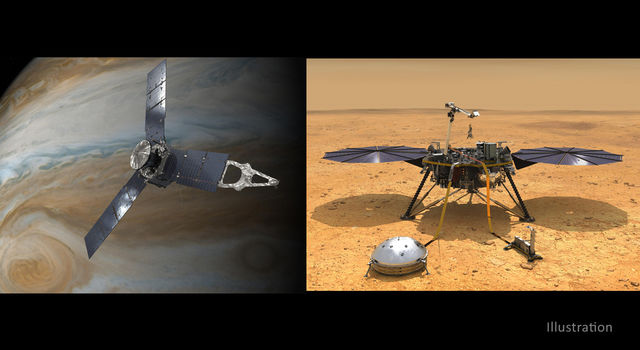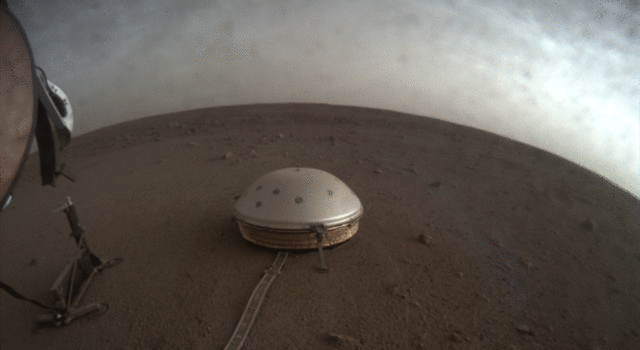Blogs | Dawn Journal | January 31, 2008
January 2008
Dear Dawnnoisseurs,
Now in interplanetary cruise, the Dawn spacecraft is following a much more leisurely pace than the one it maintained during the initial checkout phase of the mission. While its daily schedule is not demanding, as it follows (and changes) its orbit around the Sun, it is separating from Earth at nearly 4 light seconds per day (more than 1.1 million kilometers, or 720 thousand miles, per day). Every 8 hours, the probe recedes from Earth by a distance equal to that between Earth and the moon.
The spacecraft has accumulated more than 1000 hours of thrusting with its ion propulsion system. Although far far longer than the overwhelming majority of spacecraft have operated their propulsion systems, this represents only a small fraction of the total thrusting required to complete its solar system journey. [Note to editors: This milestone may be of significance only to human readers. When translated for those who use different numbering systems or different time systems, it may not yield an interesting result. (For that matter, 1000 hours is not a special number when expressed in seconds, days, or millennia.)]
Most of Dawn's time is devoted to thrusting with its ion propulsion system, but each week the spacecraft stops for a communications session with controllers on distant Earth, during which it returns detailed data on the performance of its subsystems throughout the previous week. Reports of voltages and currents, temperatures and pressures, and myriad other parameters allow engineers to determine how well the ship has been doing and how to keep it sailing as smoothly as possible.
On January 14 shortly before 10:00 pm PST, a high energy subatomic particle, a "cosmic ray," traveled through one of the main panels of the spacecraft and then penetrated one of the electronics units. The energy it carried had been imparted to it through an unidentified cosmic process, and after the particle had traveled across vast distances, that energy was transferred to a small integrated circuit. Such an event is not all that uncommon on spacecraft, and Dawn is designed so that most space radiation does not interfere with its operation. The deposition of energy in this particular component however triggered the electronics to inform the software of a problem. To rectify the situation, other software correctly responded by resetting the computer in that unit.
In the last log, we saw that two master computers work together to oversee and control activities on the spacecraft. The computer that was reset in this case was neither of those; it was one of many auxiliary computers with more limited responsibilities. In addition to resetting the computer, software running in the main computer correctly reconfigured systems onboard to "safe mode." The spacecraft then awaited instructions from engineers on Earth (or, more accurately, in Dawn mission control on the top floor of JPL's whimsically named building 264).
A few hours later, when it was time for the weekly communications session, the Deep Space Network and mission controllers promptly recognized that the spacecraft was in safe mode. As with the safing in November, a small team gathered during the night to begin the diagnosis, and more team members joined after dawn. It did not take long to reach a conclusive explanation based on the error code stored by the software and other data downloaded from the spacecraft. The culprit was a cosmic ray.
By the time the detailed analysis of the safing was concluding, mission controllers were already commanding the spacecraft step-by-step out of safe mode, returning it to its normal flight configuration. Within a few days, Dawn was ready to resume work, and before the end of the week was thrusting with its ion propulsion system again. (The effect of having missed some thrusting that week is not significant for the mission.)
While Dawn will thrust during most of its interplanetary cruise, the flight plan includes some periods of coasting in addition to the normal weekly communications session. One such period was January 22 - 25. Most of this time was devoted to updating software in the main computer.
The main software resides in 4 locations (well, 4 locations on the spacecraft): primary and backup copies in the primary main computer and primary and backup copies in the backup main computer. Three copies of flight software 7.0 were installed on the spacecraft in November. As reported in the last log, the primary main computer was scheduled to receive its backup copy during this break in thrusting.
While it had been planned before launch to transmit 7.0 to the spacecraft in November, after the software was finalized, the need for one additional change was recognized. For technical reasons it was not necessary to change all the stored copies; rather, it was sufficient to modify (or "patch") only the version that was running. Making that change on December 12 advanced the software to 7.0.1.
As Dawn moves farther from its former home, a planet it is not scheduled ever to visit again, its capability to communicate with Earth diminishes. The large main antenna is strong enough that no changes are needed yet, but the smaller, auxiliary antennas do not permit the same level of performance that they did earlier in the mission. As explained last month and before launch, when Dawn enters safe mode, it uses 1 of these auxiliary antennas. Now that the distance to Earth has increased so much, the weaker signals require lower transmission and reception rates. Engineers decided several years ago to start the mission with safe mode programmed to use data rates that were too high to work throughout the mission but would allow simplified operations during the first months of the flight. Those months have now passed, so following that plan established before launch, the software was patched to use lower data rates whenever safe mode is called. The new values were put into in the primary and backup locations in the primary and backup main computers on January 23 and 24.
With these changes, Dawn is now using flight software version 7.0.2. If you want to update the software running on your spacecraft to this latest version, with the hottest new features, we have made special arrangements to provide a copy you can download for free. (Note: this special offer is not available to customers within 1 decaparsec of Dawn.)
Replacing or updating software on an operating spacecraft is complex, and there are many opportunities for problems to arise. To allow for time to understand and resolve any unexpected difficulties, more time was allocated than was expected to be needed. As it turned out, after the team's exhaustive preparations, the software uploads went perfectly, and there was plenty of time to spare. When the work was complete, the spacecraft simply waited until the scheduled time for the resumption of thrusting on January 25, and then it returned to powered flight.
Shortly after Dawn launched, we recalled the 50th anniversary of the launch of humankind's first satellite. As our spacecraft continues in journey through space, today we remember the 50th anniversary of another launch. The United States' first craft to reach Earth orbit, Explorer 1, departed from Cape Canaveral's Space Launch Complex 26A, almost exactly 500 meters (about 0.3 miles) southwest of complex 17B, from which Dawn began its climb to space. (We don't include a link here to any previous remarks about Dawn's launch site, as it was mentioned in more than 63% of the logs posted from April through September 2007. With so many past references, readers who flow forward in time are counted upon to remember or not to care about the launch location.)
Explorer 1's elliptical orbit around Earth carried it about 2550 kilometers (1585 miles) above the surface. On this 50th anniversary of the beginning of that mission, so important in the history of space exploration and space science (as well as the Cold War), Dawn is more than 26 thousand times farther from Earth, in its own orbit around the Sun. Despite the great difference in distance (as well as other comparisons in size, mass, capabilities, technological sophistication, scientific ambition, and more, all of which we spare readers from trying to absorb), the two projects have much in common. Both are part of humanity's efforts to help broaden our perspectives beyond our home planet, to apply both engineering and scientific knowledge as we seek to gain even more such knowledge, to undertake adventures that include great challenges but offer great rewards in which everyone can share. And although it may not feel this way now, with the first mission 50 years in the past and the second just starting, for most of humanity's future, both will be among the first tentative probes into the cosmic unknown.
Dawn is 67 million kilometers (42 million miles) from Earth or 175 times as far as the moon. Radio signals, traveling at the universal limit of the speed of light, take more than 7.5 minutes to make the round trip.
Dr. Marc D. Rayman
7:49 pm PST January 31, 2008
TAGS:DAWN, VESTA, CERES, DWARF PLANET, MISSION, SPACECRAFT







